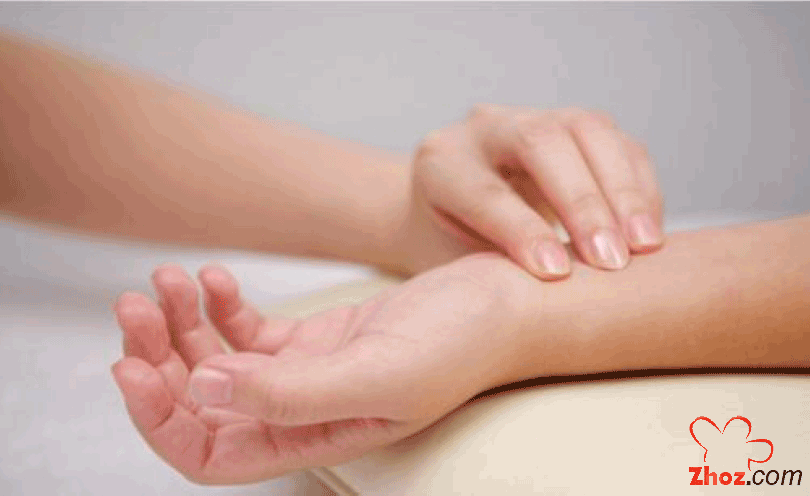中医脉诊
Pulse diagnosis refers to the speed, strength, and depth of the pulse. In the Jin Dynasty, Wang Shuhe’s “Pulse Classic” categorized the pulse into twenty-four types. In the Ming Dynasty, Li Shizhen’s “Binhai Pulse Studies” expanded this to twenty-seven types, and Li Zhongzi’s “Diagnostic Correct Views” increased it to twenty-eight types. Throughout history, while different medical practitioners have had varying classifications of pulse, there is general agreement, and modern traditional Chinese medicine recognizes twenty-eight common pulse types.
Pulse elements refer to the basic components of pulse diagnosis, including position, count, form, and force; generally divided into four main categories: floating, sinking, slow, and rapid.
Here is a mnemonic for pulse diagnosis; please take note:
Pulse theory, focus on detail, remember the three methods and four categories well. Human pulse is difficult, requiring diligent study. Observing form and distinguishing pulse types is not easy; floating, sinking, slow, and rapid are fundamental. Expand knowledge of each pulse type. This principle should be understood before diagnosis. Avoid missteps by new practitioners; remember pulse details as a consistent method. The following are key points for pulse diagnosis.
Floating Pulse: Light on palpation but none when pressed, floating pulse drifts on the surface. If floating, it indicates exterior conditions; if weak, it suggests a lack of vitality. Floating pulse has seven variations (floating tight, floating slow, floating slippery, floating rapid, floating delayed, floating empty, floating flood), which require experience to discern.
Flooding Pulse: A full and forceful pulse, like waves, strong when it comes and fades naturally. A flooding pulse signifies exuberant Yang, not necessarily indicative of fire.
Full Pulse: Full and strong with a solid feel, strongest when pressed. In acute cases, it indicates excessive fire; in chronic conditions, it may suggest Qi stagnation.
Long Pulse:
A long pulse extends beyond its usual position, resembling a long rod. It suggests strong heart and kidney function, connecting to solid pulses like a sword.
Short Pulse: Appears like a turtle, hidden at both ends. It is difficult to discern at the wrist. Short pulse indicates difficulty in treatment and often suggests Qi deficiency.
Empty Pulse: Hard on the sides, empty in the middle, resembling soft green onions. It indicates blood overflow and deficiency when observed as delayed and faint. It suggests a deficiency of Qi and blood.
Scattered Pulse: A floating and irregular pulse, scattered and unable to be consolidated. Scattered pulse is associated with early pregnancy, potential miscarriage, or severe illness.
Sinking Pulse: Heavy and pressing down like a stone sinking in water. If weak, it suggests deficiency; if strong, it indicates stagnation. Sinking pulse variations include sinking tight, sinking slippery, sinking wiry, sinking fine, sinking rapid, sinking delayed, and sinking faint.
Minute Pulse: Extremely fine and barely perceptible. It is not suitable for the young and vigorous but is typical for the elderly or weak in spring and winter.
Hidden Pulse: Extremely deep and difficult to palpate. It suggests obstruction of Qi flow and potential blockages.
Weak Pulse: Soft and feeble, indicating Qi and blood deficiency. It may suggest severe exhaustion in the young.
Deficient Pulse: Weak and slow, with a hollow feel. It indicates deficiency of both spirit and blood, often associated with excessive sweating.
Firm Pulse: Deep and strong, firm and long. It signifies persistent damage to Qi and blood, often related to symptoms like asthma or hernias.
Reeling Pulse: Rapid and floating, resembling the feeling of a drum skin. It often indicates conditions like bleeding or weakness in men or irregularities in women.
Slow Pulse: Extremely slow with a clear, weak rhythm. It can indicate cold in the exterior or internal cold conditions. Subcategories include slow, knotted, intermittent, and rough pulses.
Moderate Pulse: Even and moderate, like the gentle breeze of willows. It reflects balanced Qi and blood.
Knotted Pulse: Intermittent and irregular, associated with conditions like emotional stress or stagnation.
Intermittent Pulse: Slow and irregular, indicating severe Qi deficiency or serious conditions like pregnancy.
Rough Pulse: Difficult to smooth and irregular, reflecting Qi and blood stagnation or deficiencies.
Rapid Pulse: Fast and frequent beats, indicating heat or fire. Variants include urgent, tight, wiry, slippery, moving, and hurried pulses. A rapid pulse over the standard rate signifies a severe condition.
Tight Pulse: Fast and wiry, resembling a tight rope. It suggests cold conditions if floating and pain if deep.
Wiry Pulse: Stiff and straight, like a taut string. It reflects the severity of illness and is assessed by its strength and flexibility.
Slippery Pulse: Smooth and flowing, like pearls rolling. It often indicates digestive issues or pregnancy in women.
Moving Pulse: Unstable and irregular, like a bean-shaped circle. It indicates palpitations, anxiety, or sweating.
Hasty Pulse: Extremely rapid, reflecting severe heat or fire conditions.
Thin Pulse: Weak and floating, often suggesting blood and Qi deficiency. It reflects overall weakness and potential for night sweats.Understanding these pulse types and their characteristics is crucial for accurate diagnosis and treatment.
脉象,是指脉搏的快慢、强弱、深浅的情况;
晋·王叔和《脉经》细分为二十四脉,
明·李时珍《濒湖脉学》增为二十七脉,
明·李中梓《诊家正眼》增为二十八脉,
古往今来,不同医家关于脉象的分类虽有差异,但是大体一致,现代中医认为,常见脉象有28种。
脉象要素指脉象的基本组成部分,包括位、数、形、势等四个方面;一般分为浮、沉、迟、数四大类。
以下为脉象口诀,请仔细品味:
脉理兮,用心细,三法四中要熟记。
人脉难,需勤理,察形辨象非容易,浮沉迟数力为中,扩充各脉真消息,此理需明未诊前,免之新医,吃脉记,经为一贯用心机,指下回声诊妙记。
浮脉:轻寻有、按无有,浮脉漂然肉上游,水帆木浮未定向,浮脉中间仔细究,有力恶风见表实,无神无力指虚浮,浮脉里有七瓣(浮紧、浮缓、浮滑、浮数、浮迟、浮虚、浮洪),其中理性要经验。
洪脉:洪脉满指波涛似,来时力状去自然。脉洪阳盛虽夏旺,非是火盛治灾凡。
实脉:实毕毕更属长,举按充实力最强,新病逢时是火盛,久病逢时或气痛。
长脉:长脉直过本位前,迢迢自弱类长杆,心肾身强气本状,实脉相联似剑长。
短脉:短脉象形似龟,藏头露尾脉中筋,寸尺可凭关不诊,涩微动结似相随,主病逢之为难治,概似真元气多亏。
芤脉:两边实中间空,芤形脉似软如葱,寸阳见芤血上溢,芤现迟脉下流红,芤形浮细须轻诊,睡眠浮脉像得诊,气血伤耗精神损,自汗阳虚骨蒸深。
散脉:散脉形浮无沉候,如寻至数拘不定,满指散乱似扬先,按之分散难归整,产是生早胎为堕,久病脉散必丧命。
沉脉:沉脉壮重迎指,如石投水往下沉,按之无力真元弱,有力为痛滞气侵,中寒其脉均沉类,沉紧、沉滑、沉弦、沉细、沉数、沉迟、沉微,数头机关勿误人。
微脉:细微小至如弦,沉而极细最不断,春夏少年均不宜,春冬老弱确为善。
伏脉:沉之深,伏脉游,下指推筋靠骨求,真气不行症痞结,脉丧泻之不出头。
弱脉:沉细软绵似弱脉,轻寻无板重采知,元气耗损精血虚,少年可虑白头矣。
虚脉:虚脉举指迟大软,按之无力又空洞,精神气血都伤损,病因虚法,汗多中。
牢脉:沉而伏力很强,牢形实大和弦长,劳伤微疾真精损,气喘腹疝,七情伤。
革脉:革脉肢体自浮急,象诊真似按鼓皮,女人半产并崩漏,男子血虚或“梦遗”。
迟脉:寻肉内至来三,来往极慢微迟脉,浮迟表寒是表证,沉迟里冷必定见。缓、结、代、涩居迟类,不究详细莫轻谈。
缓脉:缓四至通不偏,和风杨柳袅自然,欲从脉里求神气,只在从容和缓间,缓迟气血皆伤损,和缓从容为气安。
结脉:缓一指复又来,结脉肢体记在怀,悲虑积中成郁结,五芤交攻为痞灾。(五芤:气、血、痰、饮、食)
代脉:缓之不能随手知,良久方来是代脉,代是气衰凶且甚,妊娠奉同生机存。
涩脉:脉道涩难疏通,细迟短散何成形,来往湿滞似刮竹,病蚕食叶慢又难,思虚交愁里积久,不但损血又伤精。
数脉:来往速数脉形,一息六至仔细凭,数脉属阳热可知,只把虚实火来医,实要凉泻虚温补,肺病秋深却畏之。急、紧、弦、滑、动、促都从数脉安排定。疾脉:快过数者脉名疾,载阳又可阳凶升。
紧脉:数又弦疾和成紧,举如转索切绳形。浮紧表寒身体痛,沉紧逢见腹疼痛。
弦脉:举迎手按不转,弦长端直若丝弦,受病轻重如何认,指在弦上软硬看。
滑脉:滑脉如珠滚滚来,往来流利却还前,停食痰气胸中瘀,妇女滑缓定是胎。动脉:动脉摇摇数在关,没头没尾豆形圈,动主惊悸心空虚,汗出发热阴阳参。促脉:数又止促脉乎,进必无生退可生,促脉三焦火焰盛,原因有五细推求。血、气、痰、食、饮停留一种治病由。
濡脉:浮取极不力,按之随手又空空,主病血虚阳虚症,汗多夜间骨热蒸。凭脉验证如明镜,学者用心都精通。
